Delhi’s Heritage Trail beckons explorers to unravel the tapestry of monuments and temples that have withstood the test of time, a mere glimpse into the city’s storied past.
The journey begins amidst the grandeur of Jama Masjid, leading curious minds through a labyrinth of historical narratives waiting to be unearthed. Each step promises a revelation, from the spiritual haven of Gurudwara Bangla Sahib to the architectural marvels that dot the landscape.
As the tour unfolds, visitors are tantalized by the promise of discovering Delhi’s soul through its cherished heritage sites.
Key Points
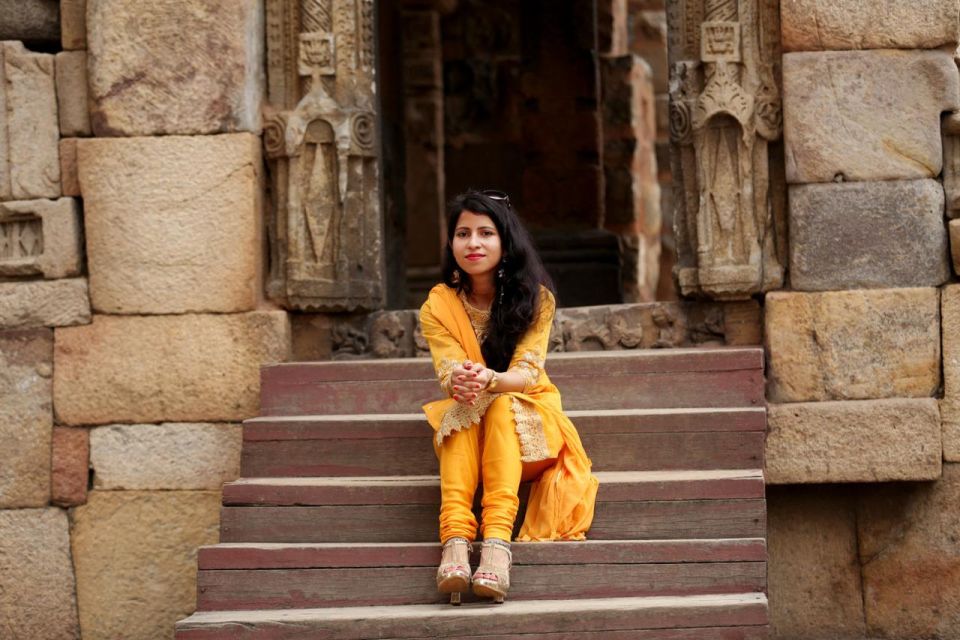
- Explore Delhi’s rich history through iconic landmarks like Jama Masjid and Qutub Minar.
- Experience cultural diversity at Gurudwara Bangla Sahib and the Lotus Temple.
- Commemorate India’s past at India Gate, Humayun’s Tomb, and Raj Ghat.
- Engage in guided tours to explore the architectural brilliance of Mughal and modern structures.
It's also worth checking out some other tours and experiences nearby.
Historical Significance of Jama Masjid
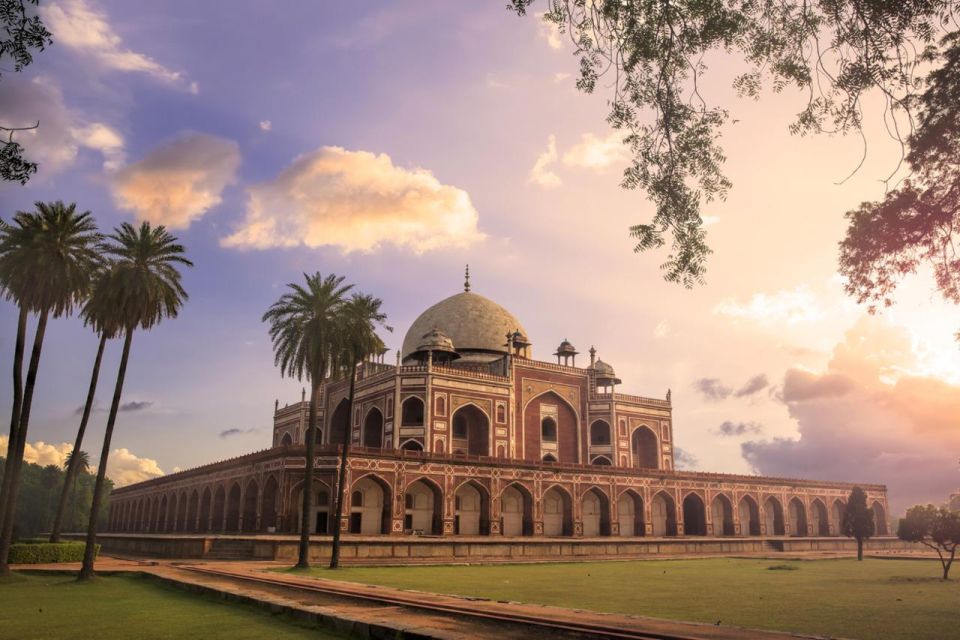
Constructed during the Mughal era, Jama Masjid in Delhi stands as a testament to the grandeur and architectural prowess of that time. Its historical significance lies in being one of the largest mosques in India, built by Emperor Shah Jahan.
The mosque’s architectural beauty is awe-inspiring, with intricate carvings, towering minarets, and a vast courtyard capable of accommodating thousands of worshippers. Jama Masjid not only serves as a place of worship but also holds immense cultural heritage and religious importance for the Muslim community.
Visitors can marvel at the stunning domes, red sandstone walls, and the overall grand design that reflects the architectural finesse of the Mughal period, making it a must-visit for those interested in history and art.
You can also read our reviews of more tours and experiences in New Delhi.
Spiritual Experience at Gurudwara Bangla Sahib
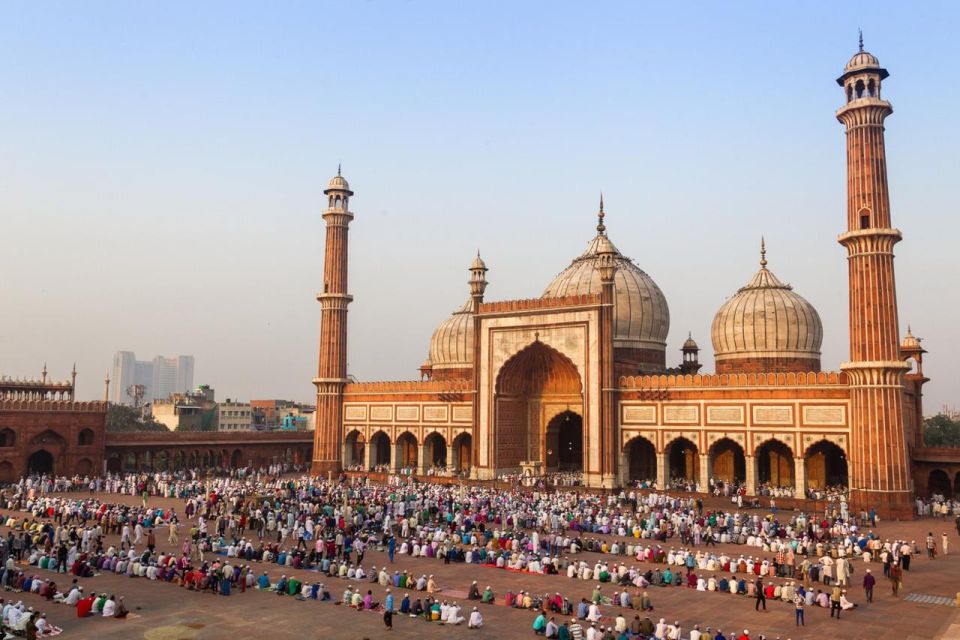
Nestled in the heart of Delhi, Gurudwara Bangla Sahib offers visitors a serene and spiritually enriching oasis amidst the bustling cityscape. This spiritual retreat welcomes all, providing a peaceful escape from the urban chaos. The Gurudwara not only serves as a place of worship but also stands as a symbol of Sikhism’s core values of peace, unity, and community service.
Visitors can participate in community kitchens that serve free meals to thousands daily, showcasing the essence of selfless service. The tranquil Sarovar (sacred pool) within the premises further enhances the spiritual experience, inviting individuals to reflect and find inner peace.
Gurudwara Bangla Sahib is a must-visit for those seeking a blend of spiritual solace and meaningful community engagement.
Commemorating Bravery at India Gate
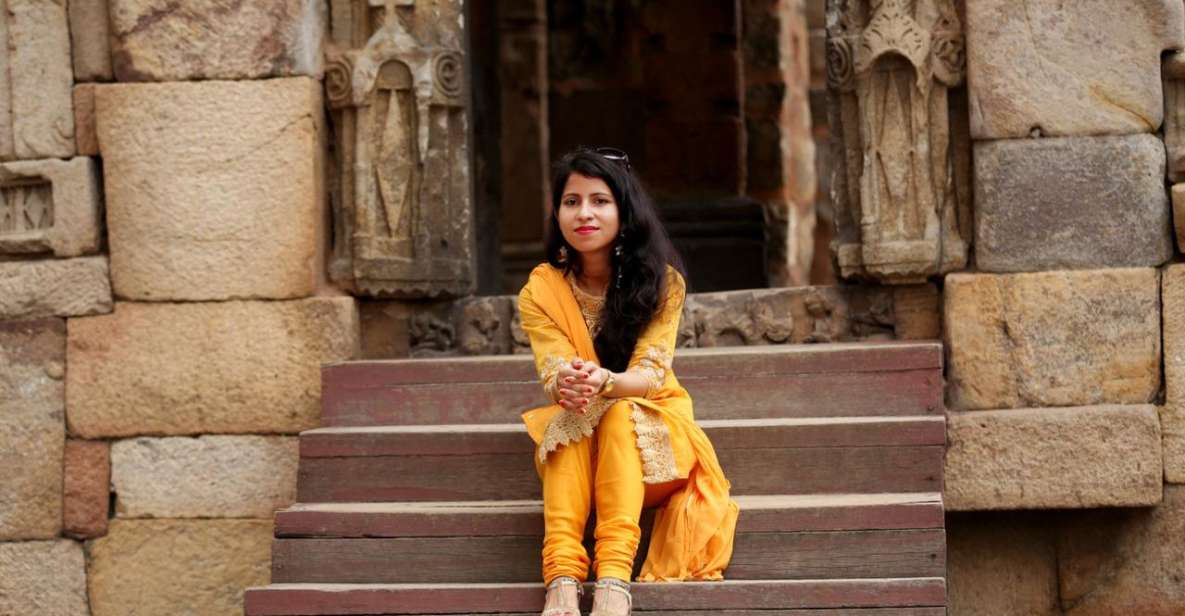
Standing tall in the heart of Delhi, India Gate pays tribute to the valor and sacrifice of the Indian soldiers who served during times of conflict. The monument stands as a symbol of national pride, reminding visitors of the bravery and dedication of those who fought for their country.
Here are some key aspects of India Gate:
-
Architectural Symbol: Designed by Sir Edwin Lutyens, India Gate’s architecture is a blend of Indian and Western styles.
-
Eternal Flame: The Amar Jawan Jyoti, or the Flame of the Immortal Soldier, burns day and night as a memorial tribute to the soldiers who laid down their lives.
-
Inscription: The gate bears the names of soldiers who sacrificed their lives in World War I.
-
Surrounding Gardens: The well-maintained lawns and gardens around India Gate offer a peaceful retreat for visitors and locals alike.
Architectural Brilliance of Humayun’s Tomb

Humayun’s Tomb, a masterpiece of Mughal architecture, stands as a testament to the intricate craftsmanship and grandeur of the era, drawing visitors into a world of historical splendor.
This architectural marvel, built-in 1570, holds immense historical significance as it was the first garden-tomb on the Indian subcontinent. The tomb’s symmetrical layout, intricate carvings, and majestic dome reflect the quintessence of Mughal architectural style.
It served as an inspiration for the construction of the iconic Taj Mahal. The red sandstone structure adorned with white marble inlays showcases the fusion of Persian and Indian architectural elements.
Visitors are captivated by the serenity and grandiosity of Humayun’s Tomb, making it a must-visit for those interested in exploring the rich tapestry of Mughal architecture.
Serene Beauty of Lotus Temple
Surrounded by lush greenery and tranquil pools, the Lotus Temple beckons visitors with its architectural elegance and spiritual ambiance, inviting peaceful contemplation and reflection. The unique design of the Lotus Temple symbolizes unity and harmony among different faiths, making it a significant landmark in Delhi’s cultural landscape.
Here are some aspects that make the Lotus Temple a must-visit destination:
-
Architectural Serenity: The Lotus Temple’s flower-like shape and pristine white marble construction create a serene and calming atmosphere for visitors.
-
Symbolic Unity: Representing the oneness of humanity, the Lotus Temple welcomes people of all backgrounds to meditate and pray together.
-
Tranquil Surroundings: The temple’s setting amidst beautifully landscaped gardens and pools enhances its tranquil ambiance.
-
Spiritual Oasis: Visitors can find solace and inner peace in the quietude of this architectural marvel.
Ancient Marvel of Qutb Minar
With its towering height and intricate stone carvings, Qutb Minar stands as a testament to the architectural prowess of ancient India. This UNESCO World Heritage Site in Delhi is a remarkable example of architectural history, dating back to the 12th century.
The minaret, reaching a height of 73 meters, is adorned with intricate inscriptions from the Quran and decorative motifs. Qutb Minar holds immense cultural significance as a symbol of the beginning of Muslim rule in India. It represents a blend of Indo-Islamic architecture, showcasing the influence and creativity of that era.
Visitors can marvel at the minaret’s detailed craftsmanship and learn about its historical and cultural importance during a guided tour, making it a must-visit destination for history enthusiasts and architecture lovers alike.
Cultural Immersion at Akshardham
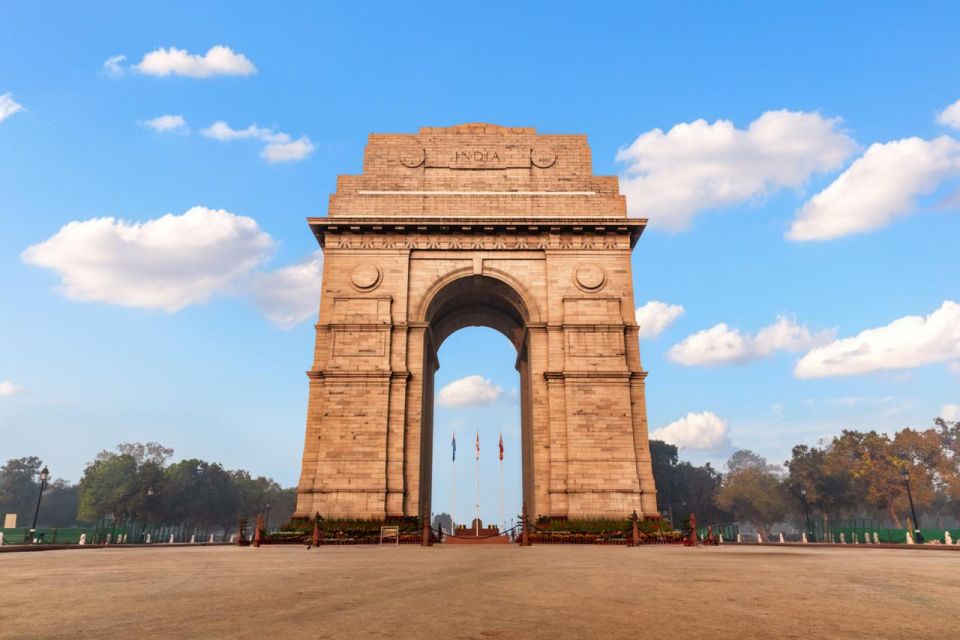
After exploring the ancient marvel of Qutb Minar, visitors can enjoy a cultural journey at Akshardham, a magnificent temple complex in Delhi that showcases intricate craftsmanship and spiritual significance. The experience at Akshardham offers a blend of culture and spiritual serenity through:
-
Architectural Splendor: Admire the stunning architecture that reflects traditional Indian design.
-
Exhibitions: Explore exhibitions that explore the rich cultural and spiritual heritage of India.
-
Gardens and Water Shows: Find tranquility in the beautifully landscaped gardens and enjoy the mesmerizing water show.
-
Prayer and Meditation: Engage in moments of reflection, prayer, and meditation in the peaceful ambiance of the temple complex.
Akshardham provides a unique opportunity for visitors to connect with India’s cultural and spiritual essence.
Reflections at Raj Ghat
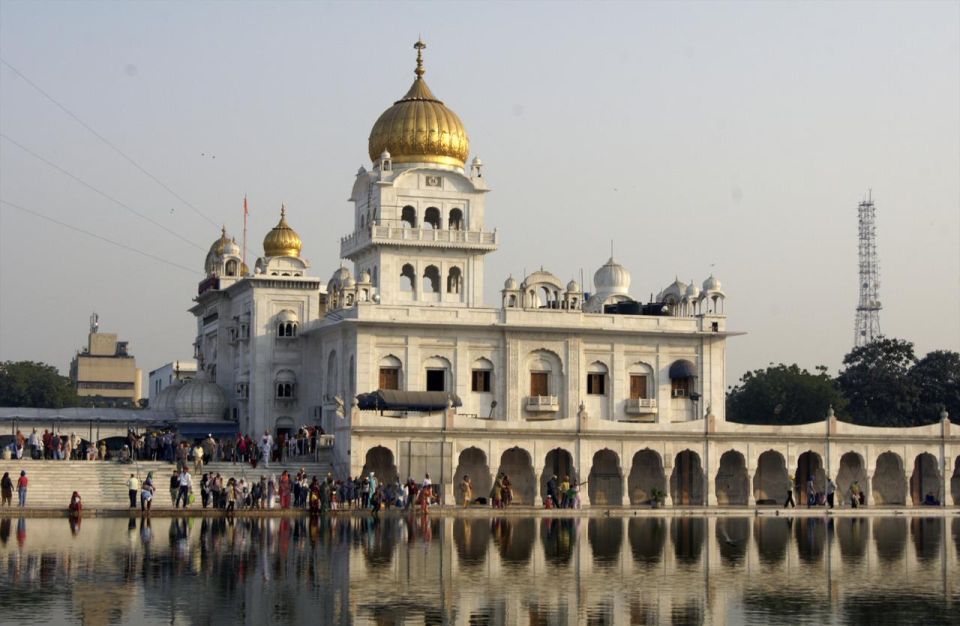
Nestled along the banks of the Yamuna River in Delhi, Raj Ghat serves as a peaceful memorial dedicated to Mahatma Gandhi. Visitors often find themselves immersed in contemplative reflections at this historical site, where they can pay homage to the Father of the Nation.
The significance of Raj Ghat lies in its role as the spot where Gandhi was cremated after his assassination in 1948. Surrounded by lush greenery and simple elegance, the memorial evokes a sense of serenity and reverence. It stands as a timeless symbol of Gandhi’s teachings and his nonviolent struggle for India’s independence.
Raj Ghat encapsulates the essence of simplicity and peace, inviting visitors to reflect on the enduring legacy of one of the world’s most influential leaders.
Here's a few more nearby tours and experiences we think you'll like.
Common questions
What Is the Best Time of Day to Visit the Lotus Temple to Experience Its Serene Beauty?
The best time to visit the Lotus Temple to experience its serene beauty is during the early morning hours. The tranquil atmosphere and soft light at sunrise enhance the temple’s peaceful ambiance, creating a truly serene experience.
Are There Any Special Rituals or Ceremonies That Take Place at Gurudwara Bangla Sahib That Visitors Can Participate In?
Visitors at Gurudwara Bangla Sahib can engage in sacred rituals like Karah Parshad distribution and Langar service, embracing Sikh religious customs. Participation in washing utensils or helping in food preparation offers a profound involvement in the community’s practices.
Can Visitors Climb to the Top of Qutb Minar for a Bird’s Eye View of Delhi?
Visitors cannot climb to the top of Qutb Minar due to climbing restrictions and safety precautions. The structure’s historical significance and architectural beauty can still be admired from the ground, offering a unique perspective of Delhi.
Is Photography Allowed Inside Humayun’s Tomb to Capture the Architectural Brilliance of the Site?
Yes, visitors can take photographs inside Humayun’s Tomb to capture its architectural brilliance. The photography rules allow capturing the intricate interior design of the site. It’s a great opportunity to document and admire the historical and artistic significance.
Are There Any Specific Guidelines or Dress Codes to Be Followed When Visiting Akshardham for a Cultural Immersion Experience?
When visiting Akshardham for a culture experience, visitors should adhere to cultural etiquette and wear appropriate attire. Modest clothing that covers shoulders and knees is recommended to show respect for the sacred surroundings.
Not for you? Here's more of our most recent tour reviews happening neaby
- From Delhi: Jaipur Day Tour by Car
- From Delhi: 2-Day Golden Triangle Tour to Agra & Jaipur
- Private: 8 Nights 9 Days Golden Triangle With Varanasi
- From Delhi: Taj Mahal, Agra Fort Day Tour With Transfers
- From Delhi: Jaipur Private Day Tour By Train
- From Delhi: Private Guided Day Trip to Haridwar & Rishikesh
- Agra Full Day & Overnight Private Tour With Fatehpur Sikri
- From Delhi: Taj Mahal Sunrise Tour By Car
- From Delhi: Private Sunrise Tour to Taj Mahal and Agra Fort
- Delhi: Old & New Delhi Private Full- or Half-Day Guided Tour
- From Delhi: Taj Mahal Sunrise and Agra Fort Private Day Tour
- From Delhi: 4-Day Agra, Jaipur and Delhi Private Tour
- From Delhi: Private 4 Days 3 Nights Golden Triangle Tour
- From Taj to Jodhpur A 7-Day Indian Adventure
- Delhi: Private Half-Day Guided City Sightseeing Tour
Sum Up
To sum it up, Delhi’s Heritage Trail: Monuments and Temples tour offers a fascinating journey through the city’s rich history and cultural diversity.
From the grandeur of Jama Masjid to the spiritual experience at Gurudwara Bangla Sahib, each landmark tells a unique story.
With iconic sites like India Gate, Humayun’s Tomb, and Qutb Minar, visitors can explore India’s architectural brilliance and historical significance.
This tour is a perfect blend of exploration and enlightenment, showcasing the beauty and heritage of Delhi’s monuments and temples.
More Tour Reviews in New Delhi
- From Delhi: Jaipur Day Tour by Car
- From Delhi: 2-Day Golden Triangle Tour to Agra & Jaipur
- Private: 8 Nights 9 Days Golden Triangle With Varanasi
- From Delhi: Taj Mahal, Agra Fort Day Tour With Transfers
- From Delhi: Jaipur Private Day Tour By Train
- From Delhi: Private Guided Day Trip to Haridwar & Rishikesh
Not for you? Here's more nearby things to do in New Delhi we have reviewed
- From Delhi: Jaipur Day Tour by Car
- Private: 8 Nights 9 Days Golden Triangle With Varanasi
- From Delhi: Taj Mahal, Agra Fort Day Tour With Transfers
- From Delhi: Jaipur Private Day Tour By Train
- From Delhi: Private Guided Day Trip to Haridwar & Rishikesh
- Agra Full Day & Overnight Private Tour With Fatehpur Sikri
- From Delhi: Taj Mahal Sunrise Tour By Car
- From Delhi: Private Sunrise Tour to Taj Mahal and Agra Fort
- Delhi: Old & New Delhi Private Full- or Half-Day Guided Tour
- From Delhi: Taj Mahal Sunrise and Agra Fort Private Day Tour
- From Delhi: 4-Day Agra, Jaipur and Delhi Private Tour
- From Delhi: Private 4 Days 3 Nights Golden Triangle Tour
